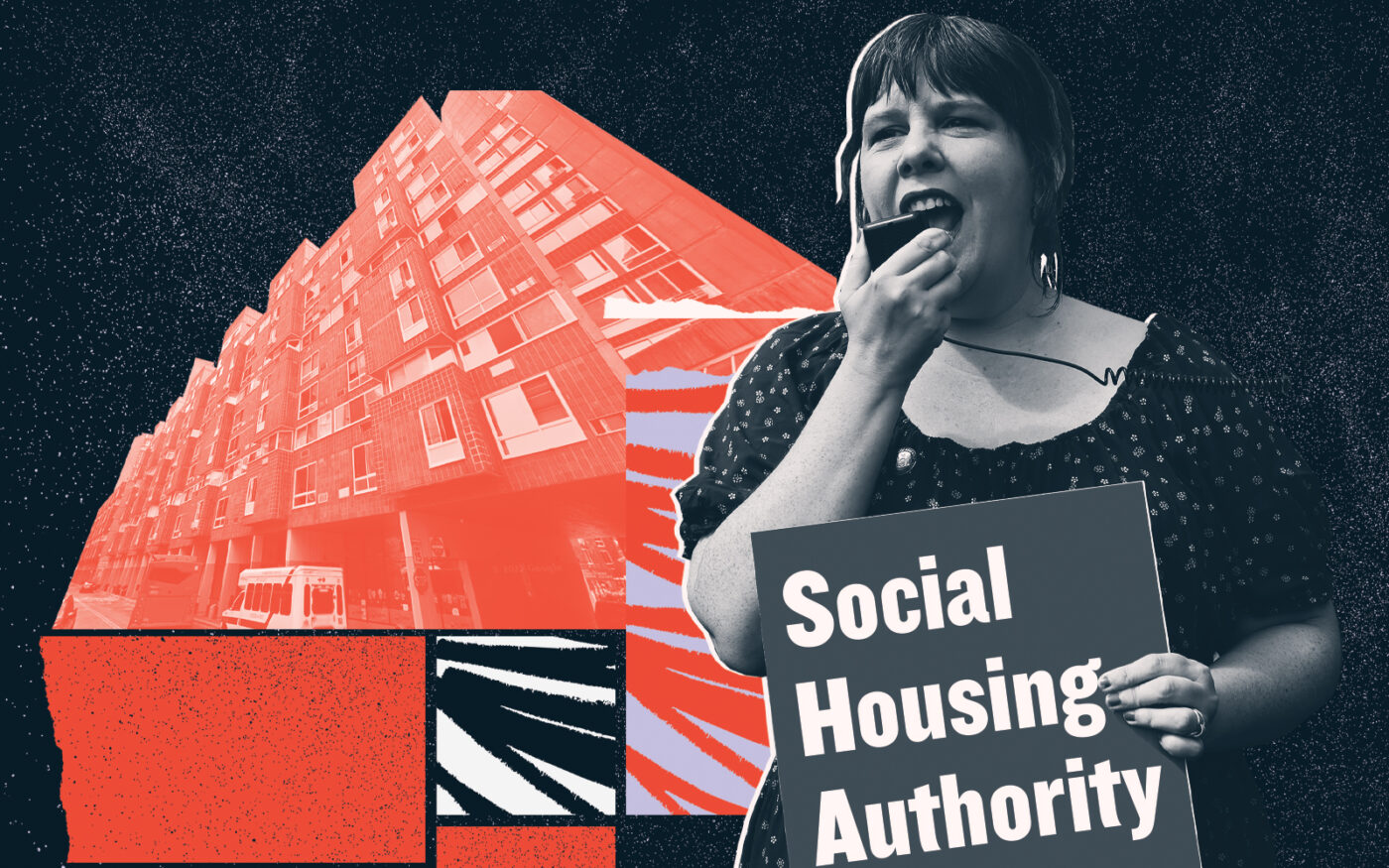Is it time for public housing 2.0?
Shortage triggers efforts to get government into development again

After struggling to find a private equity partner, a developer turned to the local government with an unusual pitch.
Maryland-based EYA asked Montgomery County to take a majority stake in a 268-unit apartment building it was constructing in Derwood, a little less than an hour from Washington, D.C. The project would be financed by a county-run housing fund that would be replenished by revenue from the free-market rentals.
“It is a 70 percent market-rate building, so it is a performing asset,” said EYA CEO McLean Quinn. “It is not designed to have long-term subsidy requirements. This is designed to be self-sustaining.”
Call it public housing 2.0.
Like Montgomery County and some other local governments, New York is now asking why the government can’t just build the housing its residents desperately need.
The short answer: Someone has to pay for it.
“You have to look at the fundamental challenge of building affordable housing: reconciling the very high costs of building and the low prices in rents,” said Howard Slatkin, executive director of the New York City-based Citizens Housing & Planning Council. “This is about how best to allocate a limited set of resources.”
New York’s pitch
The term “social housing” encompasses various ownership models, all with an emphasis on divorcing housing from market forces. Decades of disinvestment and mismanagement have stigmatized the idea — and word choice — of public housing. But it’s not clear that a new moniker resolves the challenges of building public housing.
That did not stop New York state lawmakers this year from proposing a Social Housing Authority that would build and own affordable housing. The authority would renovate buildings or acquire land to construct permanently affordable homes.
“Reliance on the private market has exacerbated New York’s housing shortage and cost-of-living crisis,” Assembly member Emily Gallagher, a sponsor of the longshot legislation, said in a statement.
Like the Montgomery County model, New York’s Social Housing Authority would still rely on the private sector. The authority would issue bonds for purchase by private investors, and companies would bid to do the construction. Nonprofit and for-profit developers would likely oversee the work. Gallagher’s office indicated that the hope is to build some in-house expertise at the state level as well.
Penciling out
Montgomery County’s Housing Opportunities Commission serves as a public housing authority, a financing agency and a public developer. Its financing arm issues bonds that are paid back using revenue from the rentals created, 70 percent of which are market-rate. The agency provides low-interest loans to developers and exempts projects from property taxes on projects where it is the majority owner.
New York’s proposal would also build mixed-income housing, but it differs in a few key ways. Rents would be affordable to households making up to 165 percent of the area’s median income, and annual rent increases on affordable units would be capped at 2 percent. Critics say that would limit the market value of the bonds and potentially scare away investors.
The proposal also calls for an initial capital infusion of $5 billion from the state and a steady flow of public subsidies. Construction workers on the projects would be paid union-level wages.
New York has a shortage of 667,000 homes for extremely low-income renters, according to the National Low Income Housing Coalition. Gov. Kathy Hochul has said the state needs to build 800,000 homes over the next decade.
It is unclear how many units the Social Housing Authority would be able to build and if it would be more efficient than existing programs.
“We risk just shifting existing pots of money around and not getting at the issue that our current resources are not going far enough to meet people’s housing needs,” said Matthew Murphy, executive director of New York University’s Furman Center, which is studying public housing models. Still, he said, the conversation shows that policymakers are willing to “act boldly and innovatively.”
Gallagher said she is confident the 2 percent increases would cover maintenance and operation costs as well as debt service. She said the bill includes an option for higher increases, if necessary, and that she is open to creating a revolving fund similar to Montgomery County’s.
But her bill does not account for the long-term costs of managing and maintaining these properties, said Jay Martin, executive director of landlord group Community Housing Improvement Program.
New York City’s existing public housing needs $78 billion worth of repairs — about $445,000 per unit. Disillusionment with public housing, which was seen as concentrating poverty and breeding crime, led in 1998 to the Faircloth Amendment, a ban on funding more of it with federal money.
Martin also questioned if the $5 billion in state funds would not be better invested in rental vouchers than in new construction.
“If they can prove that it pencils out, go with God, have at it,” he said.
Second time’s the charm
For those who remember New York’s Urban Development Corporation, an inspiration for the social housing proposal, Gallagher’s bill may induce déjà vu.
The agency was created in the late 1960s, also in the midst of a housing crisis. At the time, developers complained about project delays from red tape and lack of subsidies. Edward Logue, the UDC’s president and CEO, lamented that builders were leaving New York for Florida, according to “Saving America’s Cities,” a book about Logue and the agency.
The UDC built 33,000 homes across the state over seven years. Much can be learned from this agency’s short life.
Launched in 1968, the UDC was effective in part because it had the power to seize properties through eminent domain and override local zoning in communities hostile to new housing. The Social Housing Authority would have the same power. Then as now, threats of eminent domain spurred protests.
The UDC also fast-tracked projects, moving forward with cash on hand before all of the funding, permitting and bidding was completed, according to “Saving America’s Cities.”
Could this history bode well for a Social Housing Authority?
“Yes, of course, but the basis on which the UDC succeeded and also failed was it had a lot of liberty,” said Elizabeth Kamell, associate professor of architecture at Syracuse University, who co-authored a guide to the UDC’s projects. “That kind of liberty could really backfire.”
Some communities felt steamrolled by the UDC, prompting state legislators in 1973 to strip the agency of its power to sidestep local zoning outside New York City. That severely limited its ability to deliver housing.
Federal funding was the UDC’s lifeblood, but then Washington slashed it. The agency also struggled to sell bonds as interest rates rose and doubt mounted that the state would make good on its obligations. New York City, meanwhile, was on the verge of bankruptcy.
The UDC ran out of funding in 1975 and was eventually absorbed by the Empire State Development Corporation. Federal funding for housing has remained scarce.
Supporters of the Social Housing Authority bill are hopeful that localities will be more receptive to the proposal than they were to Hochul’s Housing Compact, her failed 2023 housing growth mandate.
A representative for the Assembly said that there will be more upfront conversations with communities and that the authority would push for affordable housing rather than housing in general.
This could help weed out opponents who “hide behind” claims that projects would not be affordable but really want to block new multifamily housing altogether, said Samuel Stein, housing policy analyst at the Community Service Society, which is backing the measure.
The UDC had powerful champions in Logue and Gov. Nelson Rockefeller. Backers of the Social Housing Authority bill lack Hochul’s support but seek to craft a wider base. Both the legislature and the governor would have to support the bill for it to pass with sufficient funding.
Lizabeth Cohen, a history professor at Harvard University and the author of “Saving America’s Cities,” said it is important to “learn from history and not sort of just invoke it.” Any successor program to the UDC needs clear protections around bond financing and a strategy for dealing with localities that do not welcome housing, she said.
“We desperately need things to happen — they just need safeguards,” Cohen said. “The UDC can be a model, but we also should recognize the ways its downfall are warnings.”
Maxed out
Much of the affordable housing built in the U.S. is financed in part by federal housing tax credits. Because those are a limited resource, communities are experimenting with new ways to boost their housing pipelines.
Rhode Island has tapped the Furman Center to study the feasibility of a revolving affordable housing fund. In Chicago, Mayor Brandon Johnson has pitched borrowing $1.25 billion through bond sales, of which up to $135 million would go to a revolving housing fund.
Last year, Seattle voted to create a Social Housing Developer. Advocates are now pushing to create a payroll tax to fund the public authority. California Gov. Gavin Newsom signed a bill into law last year that requires the state to study how to beef up its social housing offerings.
In New York, separate from the Social Housing Authority bill, the state Senate has proposed reviving the Mitchell-Lama program, which created limited-equity co-ops and affordable rentals. The new version would lease state-owned land back to developers, and unlike the predecessor program, its homes would be permanently affordable.
Montgomery County’s housing fund takes a fairly narrow approach. Officials approved issuing $100 million in bonds on an annual basis, and the county has already committed that.
“It is designed expressly to be scalable, and not to try to accomplish 10 things,” said Zachary Marks, a senior vice president of the county’s Housing Opportunity Commission. “It wasn’t worth even using the political will to do this if we didn’t believe it was going to be scalable and repeatable.”
EYA’s Quinn is planning another commission-funded project, a 413-unit building across the street from its first, which is known as the Laureate.
Quinn said working with the county brings certainty to the project, especially as financing from the private sector has contracted. But he said the model would not work for everyone.
“We have another line of business that pays a lot of our bills that gives us the patience and confidence to work on complicated projects like this,” he said. “If this was a standalone business, the economics might be a little more challenging.”




